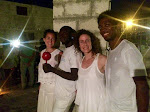The drummers began the Chasè rhythms and the sèvitè, carrying a candle and cup of water, led the participants into the public space of the peristil. The ounsi sang in response to the larenn and slowly circled around the space, filling the peristil and creating a gentle sea of dancers. Once everyone had filed out of the inner sanctum and circled the space the ounsi organized themselves into lines facing the drummers. They began the cycle of responding to the break in the drums to dance forward, then pivot in place to await the break, and then dance back again. At this point there were so many ounsi that space was limited for actual travel back and forth. Their movements were subtle yet articulate and demonstrated the various progressions of stepping side to side and traveling circularly with the weight on one foot and balanced with the back foot's heel raised. This continued through various songs and rhythms that eventually got repeated throughout the night. My two favorite songs which were sung repetitively throughout the five days of ceremonies are included in the following video clip.
Lè yo we Badé yo di se Lougawou
Kan yo we Sobo yo di se Makanda
Batikan yo de ounsi yo konnen mwee
When they see Badé (lwa) they say it's Lougawou
When they see Sobo (brother of Badé) they say it's Makanda
People who sing and serve the lwa they know me
Danbala Wedo ooo
Vodou na we yo
Aida Wedo eya
Vodou na we yo
Danbala and Aida Wedo are lwa (deities/spirits) who come from the Kingdom of
Dahomey (Daome) which is now Benin. Wedo refers to the coastal town Ouidah
which was a center of the Atlantic slave trade for almost 200 years. Danbala
represents ancient male creative energy and manifests as a snake. He is said to
connect the oceans of the heavens to the springs and fresh waters of earth. Aida is
his female counterpart represented as a rainbow who connects the earth's oceans to
the heavenly waters -- creating a earthly/heavenly cycle.
The ceremony then moved outside to honor Legba at the gate of the lakou. Songs for Legba were sung and ritual libations executed which I could not see from where I was standing. Lebga is the lwa that is always honored first. Legba is the lord of the crossroads and opens or closes the way. This is why he was saluted at the gate which acts as entryway from the road to the lakou. I was positioned right next to the drums and was using my sound recorder to collect rhythm and song samples. I was not the only one as many Haitians also had recording devices to capture the essence of these rituals. Unfortunately I did not leave Souvenance with my recorder so I don't have those samples to share but the video footage here -- while dark -- has clear examples of drum rhythms and various songs for Legba.
When the ritual honoring of Legba had finished the drummers moved their benches toward the peristil and faced the "congregation." The sèvitè and larenn led the ounsi toward the drummers. When they reached the drummers, the musicians again picked up their benches and moved closer yet to the peristil. And again, the congregation moved toward the drummers. This went on three or four times until the group entered into the peristil again, circled the space, and began the cycle of songs and rhythms, moving forward and back, singing and dancing. However, this time the energy was more celebratory than contemplative as in the initial entrance from the inner sanctum. The ounsi sang the songs stronger and with more expression. Their movements also became larger, with arms outstretched, reaching skyward. The rhythms also changed to include Wandjale, Vodou Double Nago, and dances such as the Gran Kat, the most explosive movement where one leg supports the dancer and the other leg extends forcefully back.
The ounsi stay in the middle of the space, the larenn sings from an elevated box on the side, the drummers are positioned at the front of the peristil, and the public line the benches and open windows along the sides. Everyone is allowed to dance with the ounsi but at first only a handful do. The children are especially active dancing along with the adult ounsi and more people join as the evening progresses and the days progress.
Subscribe to:
Post Comments (Atom)

2 comments:
Good documentary on our Voodoo, we need more clips like that in order to mainstream this part of our Haitian culture. Haitians have a bad habit of turning their backs on everything that gave us 200 years of independence. Hence, our country is at the bottom of the abyss today.
Thank you for your comment, Lionel. I appreciate your feedback. My desire is that this information sheds light on a tradition that is full of complexities but that I find to be extremely powerful in regard to honoring life and all of its similar complexities. I hope you have the opportunity to view the rest of the blog. Best regards.
Post a Comment